Schedule
Mango Crop Schedule
| Product Name | Fertilizers | ||||||
|---|---|---|---|---|---|---|---|
| Poornima Kit | NPK Caps | Humigrow Nano Powder |
Cropforce Nano Powder |
Alp | Sonha-Bihan | ||
| Humic Acid | Seaweed Extract | Chelated Multi-micronutrient |
PGP/PGR | ||||
| Land Reparation | month -2 | ||||||
| Soil Treatment | month -1 | ||||||
| Before Seed Sowing | month 0 | ||||||
| Germination | month 1 | 1 Kit | |||||
| Vegetative Growth | month 2 | ||||||
| month 3 | 2 Caps | 120 gm | |||||
| month 4 | |||||||
| month 5 | 1 Kit | ||||||
| month 6 | |||||||
| month 7 | 2 Caps | 120 gm | |||||
| month 8 | |||||||
| month 9 | 1 Kit | ||||||
| month 10 | |||||||
| month 11 | 2 Caps | 120 gm | |||||
| month 12 | |||||||
| Flowering | 250gm | 250gm | |||||
| Fruiting | 500gm | ||||||
| Harvesting | |||||||
| Total Quantity | 3 Kit | 6 Caps | 360gm | 750gm | 250gm | ||
| Broadcast | |
| Top Dressing | |
| Basal Dressing | |
| Soil Application | |
| Spray | |
| * | Optional |
NOTE: For the first year donot immidietaly substitute 100% chemical fertilizer with the SIESTO GREEN products, as the soil is used to chemical fertilizer, it may affect the output. So the best way to substitute is by reducing 50% of chemical input in the first year, 25% the following 2nd year, & then another 10% by the 3rd year. After the 3rd year use synthetic fertilizer / inorganic fertilizer if their is a requirement depending on the soil health.
CROP SCHEDULE FOR MANGO
Sr. No.
Treatment / Application
Product
Dose /Acre
APPLICATION
Management
1
Vegetative – Dissolve in 20 to 200 ltr. of water as required for 1 acre of land and apply through Drip Irrigation or drench.
POORNIMA KIT
1 KIT
Apply it in Month 1, month 5 & month 9
It is a balanced form of nutrients that includes NPK, Zinc, Cropforce NP, Humigrow NP, and Mycorrhiza NP
2
Vegetative – Mix all with the required amount of water and apply through drip irrigation, flood irrigation, or drenching as per farmer’s availability.
NPK + Humigrow
2 caps + 120gm
Apply it in Month 3, 7 and 11
It is a balanced form of Nutrition that includes NPK with Humic.
3
Flowering – Mix both in 200 liters of water as per requirement and spray it in the plants.
ALP + Sonhabihan
250gm + 250gm/200 lit. of water
During the flowering period spray it once.
It is a Micronutrient and PGP that helps in Growth, Fruit set, and the quality of the produce.
4
Fruiting – Mix it with the required amount of water and apply it in the soil near the plant roots.
ALP
500gm
Apply it during the fruiting stage.
It is a Multi Micronutrient.
PEST ATTACKS, BACTERIAL, OR FUNGAL MANAGEMENT
PEST / BACTERIAL / FUNGAL
IDENTIFICATION IN CROP
SYMPTOMS
SUGGESTED PRODUCT
Anthracnose
 The disease causes serious losses to young shoots, flowers, and fruits. It also affects fruits during storage.
Indofa + Bacillus
Powdery Mildew
The disease causes serious losses to young shoots, flowers, and fruits. It also affects fruits during storage.
Indofa + Bacillus
Powdery Mildew
 The characteristic symptom of the disease is the white superficial powdery fungal growth on leaves, stalks of panicles, flowers, and young fruits.
Life-line + Indofa + BT + Bacillus
Die-Back
The characteristic symptom of the disease is the white superficial powdery fungal growth on leaves, stalks of panicles, flowers, and young fruits.
Life-line + Indofa + BT + Bacillus
Die-Back
 The pathogen causing dieback, tip dieback, graft union blight, twig blight, seedling rot, wood stain, stem-end rot, black root rot, fruit rot, dry rot, brown rot of panicle, etc. The disease is most conspicuous during October and November.
Indofa + Bacillus
Phoma Blight
The pathogen causing dieback, tip dieback, graft union blight, twig blight, seedling rot, wood stain, stem-end rot, black root rot, fruit rot, dry rot, brown rot of panicle, etc. The disease is most conspicuous during October and November.
Indofa + Bacillus
Phoma Blight
 The symptoms of the disease are noticeable only on old leaves. Initially, the lesions are angular, minute, irregular, yellow to light brown, scattered over leaf lamina.
Indofa
Bacterial Canker
The symptoms of the disease are noticeable only on old leaves. Initially, the lesions are angular, minute, irregular, yellow to light brown, scattered over leaf lamina.
Indofa
Bacterial Canker
 The disease is noticed on leaves, leaf stalks, stems, twigs, branches, and fruits, initially producing water-soaked lesions, later turning into typical canker.
Bacillus Subtilis + Bacillus
Red Rust
The disease is noticed on leaves, leaf stalks, stems, twigs, branches, and fruits, initially producing water-soaked lesions, later turning into typical canker.
Bacillus Subtilis + Bacillus
Red Rust
 Red rust disease, caused by an alga, has been observed in mango-growing areas. The algal attack causes a reduction in photosynthetic activity and defoliation of leaves thereby lowering the vitality of the host plant.
Indofa + Bacillus subtilis
Mango Malformation
Red rust disease, caused by an alga, has been observed in mango-growing areas. The algal attack causes a reduction in photosynthetic activity and defoliation of leaves thereby lowering the vitality of the host plant.
Indofa + Bacillus subtilis
Mango Malformation
 Vegetative malformation: Vegetative malformation is pronounced in young seedlings. The affected seedlings develop vegetative growths which are abnormal growth, swollen, and have very short internodes.
NPK Grow + Zinc grow + Sonha-bihan
Root Rot & Damping Off
Vegetative malformation: Vegetative malformation is pronounced in young seedlings. The affected seedlings develop vegetative growths which are abnormal growth, swollen, and have very short internodes.
NPK Grow + Zinc grow + Sonha-bihan
Root Rot & Damping Off
 The disease is characterized by the sudden dropping of leaves after the emergence of seedlings from the soil.
Indofa
Scab
The disease is characterized by the sudden dropping of leaves after the emergence of seedlings from the soil.
Indofa
Scab
 Symptoms produced by the disease are very much like those of anthracnose.
Bacillus Subtilis + Bacillus
Mealybug
Symptoms produced by the disease are very much like those of anthracnose.
Bacillus Subtilis + Bacillus
Mealybug
 Nymphs and adults suck the plant sap and reduce the vigor of the Mango Plant. Excessive and continuous draining of Mango plant sap causes wilting and finally drying of infected tissue.
Traps + Meta + BT + Lifeline
Shoot Borer
Nymphs and adults suck the plant sap and reduce the vigor of the Mango Plant. Excessive and continuous draining of Mango plant sap causes wilting and finally drying of infected tissue.
Traps + Meta + BT + Lifeline
Shoot Borer
 This pest is found all over the country and larvae of this moth bore into the young shoot resulting in the dropping of leaves and wilting of shoots.
Meta + Traps + BT
This pest is found all over the country and larvae of this moth bore into the young shoot resulting in the dropping of leaves and wilting of shoots.
Meta + Traps + BT
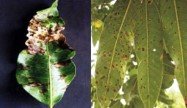 The disease causes serious losses to young shoots, flowers, and fruits. It also affects fruits during storage.
Indofa + Bacillus
Powdery Mildew
The disease causes serious losses to young shoots, flowers, and fruits. It also affects fruits during storage.
Indofa + Bacillus
Powdery Mildew
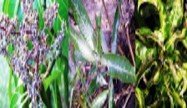 The characteristic symptom of the disease is the white superficial powdery fungal growth on leaves, stalks of panicles, flowers, and young fruits.
Life-line + Indofa + BT + Bacillus
Die-Back
The characteristic symptom of the disease is the white superficial powdery fungal growth on leaves, stalks of panicles, flowers, and young fruits.
Life-line + Indofa + BT + Bacillus
Die-Back
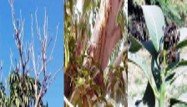 The pathogen causing dieback, tip dieback, graft union blight, twig blight, seedling rot, wood stain, stem-end rot, black root rot, fruit rot, dry rot, brown rot of panicle, etc. The disease is most conspicuous during October and November.
Indofa + Bacillus
Phoma Blight
The pathogen causing dieback, tip dieback, graft union blight, twig blight, seedling rot, wood stain, stem-end rot, black root rot, fruit rot, dry rot, brown rot of panicle, etc. The disease is most conspicuous during October and November.
Indofa + Bacillus
Phoma Blight
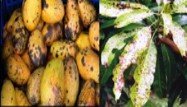 The symptoms of the disease are noticeable only on old leaves. Initially, the lesions are angular, minute, irregular, yellow to light brown, scattered over leaf lamina.
Indofa
Bacterial Canker
The symptoms of the disease are noticeable only on old leaves. Initially, the lesions are angular, minute, irregular, yellow to light brown, scattered over leaf lamina.
Indofa
Bacterial Canker
 The disease is noticed on leaves, leaf stalks, stems, twigs, branches, and fruits, initially producing water-soaked lesions, later turning into typical canker.
Bacillus Subtilis + Bacillus
Red Rust
The disease is noticed on leaves, leaf stalks, stems, twigs, branches, and fruits, initially producing water-soaked lesions, later turning into typical canker.
Bacillus Subtilis + Bacillus
Red Rust
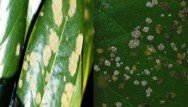 Red rust disease, caused by an alga, has been observed in mango-growing areas. The algal attack causes a reduction in photosynthetic activity and defoliation of leaves thereby lowering the vitality of the host plant.
Indofa + Bacillus subtilis
Mango Malformation
Red rust disease, caused by an alga, has been observed in mango-growing areas. The algal attack causes a reduction in photosynthetic activity and defoliation of leaves thereby lowering the vitality of the host plant.
Indofa + Bacillus subtilis
Mango Malformation
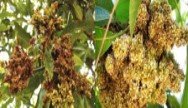 Vegetative malformation: Vegetative malformation is pronounced in young seedlings. The affected seedlings develop vegetative growths which are abnormal growth, swollen, and have very short internodes.
NPK Grow + Zinc grow + Sonha-bihan
Root Rot & Damping Off
Vegetative malformation: Vegetative malformation is pronounced in young seedlings. The affected seedlings develop vegetative growths which are abnormal growth, swollen, and have very short internodes.
NPK Grow + Zinc grow + Sonha-bihan
Root Rot & Damping Off
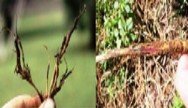 The disease is characterized by the sudden dropping of leaves after the emergence of seedlings from the soil.
Indofa
Scab
The disease is characterized by the sudden dropping of leaves after the emergence of seedlings from the soil.
Indofa
Scab
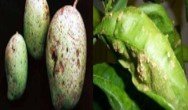 Symptoms produced by the disease are very much like those of anthracnose.
Bacillus Subtilis + Bacillus
Mealybug
Symptoms produced by the disease are very much like those of anthracnose.
Bacillus Subtilis + Bacillus
Mealybug
 Nymphs and adults suck the plant sap and reduce the vigor of the Mango Plant. Excessive and continuous draining of Mango plant sap causes wilting and finally drying of infected tissue.
Traps + Meta + BT + Lifeline
Shoot Borer
Nymphs and adults suck the plant sap and reduce the vigor of the Mango Plant. Excessive and continuous draining of Mango plant sap causes wilting and finally drying of infected tissue.
Traps + Meta + BT + Lifeline
Shoot Borer
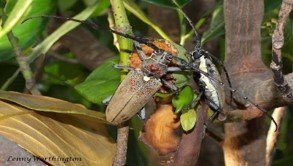 This pest is found all over the country and larvae of this moth bore into the young shoot resulting in the dropping of leaves and wilting of shoots.
Meta + Traps + BT
This pest is found all over the country and larvae of this moth bore into the young shoot resulting in the dropping of leaves and wilting of shoots.
Meta + Traps + BT
NUTRITION DEFICIENCY
NUTRIENT
IDENTIFICATION
SYMPTOMS
SUGGESTED PRODUCT
Potassium
 Scorching of leaf margins is the characteristic symptom of potassium deficiency. Scorching starts from the tip downwards. Fruit quality is reduced. Trees with potassium deficiency are easily prone to pest and disease attacks.
Potash Grow Caps
Nitrogen
Scorching of leaf margins is the characteristic symptom of potassium deficiency. Scorching starts from the tip downwards. Fruit quality is reduced. Trees with potassium deficiency are easily prone to pest and disease attacks.
Potash Grow Caps
Nitrogen
 Yellow undersized leaves, severe retardation of growth, twigs become yellow in color. Fruits are smaller and mature early. Leaves small with general yellowing
Azoss / Azoto
Phosphorus
Yellow undersized leaves, severe retardation of growth, twigs become yellow in color. Fruits are smaller and mature early. Leaves small with general yellowing
Azoss / Azoto
Phosphorus
 The deficiency causes stunting of growth, premature defoliation, dying back from the tips, excessively green younger leaves, and thin and willowy wood of the main trunk.
PSB Plus
Zinc
The deficiency causes stunting of growth, premature defoliation, dying back from the tips, excessively green younger leaves, and thin and willowy wood of the main trunk.
PSB Plus
Zinc
 The leaves become small and narrow with leaf margins bent upward or downward. Inter nodal length is reduced drastically and the twig with crowded leaves gives a rosette appearance.
Zinc Grow Caps
Iron
The leaves become small and narrow with leaf margins bent upward or downward. Inter nodal length is reduced drastically and the twig with crowded leaves gives a rosette appearance.
Zinc Grow Caps
Iron
 The leaves lose their green color and turn white which is called “Bleaching”. The size of the leaf is reduced. In severe cases of iron deficiency, the leaves dry from the tip downwards.
ALP
Copper
The leaves lose their green color and turn white which is called “Bleaching”. The size of the leaf is reduced. In severe cases of iron deficiency, the leaves dry from the tip downwards.
ALP
Copper
 Copper deficiency symptoms frequently develop on young trees which generally occur due to heavy nitrogenous fertilization. It may also be accompanied by Zinc deficiency symptoms.
ALP
Copper deficiency symptoms frequently develop on young trees which generally occur due to heavy nitrogenous fertilization. It may also be accompanied by Zinc deficiency symptoms.
ALP
 Scorching of leaf margins is the characteristic symptom of potassium deficiency. Scorching starts from the tip downwards. Fruit quality is reduced. Trees with potassium deficiency are easily prone to pest and disease attacks.
Potash Grow Caps
Nitrogen
Scorching of leaf margins is the characteristic symptom of potassium deficiency. Scorching starts from the tip downwards. Fruit quality is reduced. Trees with potassium deficiency are easily prone to pest and disease attacks.
Potash Grow Caps
Nitrogen
 Yellow undersized leaves, severe retardation of growth, twigs become yellow in color. Fruits are smaller and mature early. Leaves small with general yellowing
Azoss / Azoto
Phosphorus
Yellow undersized leaves, severe retardation of growth, twigs become yellow in color. Fruits are smaller and mature early. Leaves small with general yellowing
Azoss / Azoto
Phosphorus
 The deficiency causes stunting of growth, premature defoliation, dying back from the tips, excessively green younger leaves, and thin and willowy wood of the main trunk.
PSB Plus
Zinc
The deficiency causes stunting of growth, premature defoliation, dying back from the tips, excessively green younger leaves, and thin and willowy wood of the main trunk.
PSB Plus
Zinc
 The leaves become small and narrow with leaf margins bent upward or downward. Inter nodal length is reduced drastically and the twig with crowded leaves gives a rosette appearance.
Zinc Grow Caps
Iron
The leaves become small and narrow with leaf margins bent upward or downward. Inter nodal length is reduced drastically and the twig with crowded leaves gives a rosette appearance.
Zinc Grow Caps
Iron
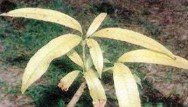 The leaves lose their green color and turn white which is called “Bleaching”. The size of the leaf is reduced. In severe cases of iron deficiency, the leaves dry from the tip downwards.
ALP
Copper
The leaves lose their green color and turn white which is called “Bleaching”. The size of the leaf is reduced. In severe cases of iron deficiency, the leaves dry from the tip downwards.
ALP
Copper
 Copper deficiency symptoms frequently develop on young trees which generally occur due to heavy nitrogenous fertilization. It may also be accompanied by Zinc deficiency symptoms.
ALP
Copper deficiency symptoms frequently develop on young trees which generally occur due to heavy nitrogenous fertilization. It may also be accompanied by Zinc deficiency symptoms.
ALP


